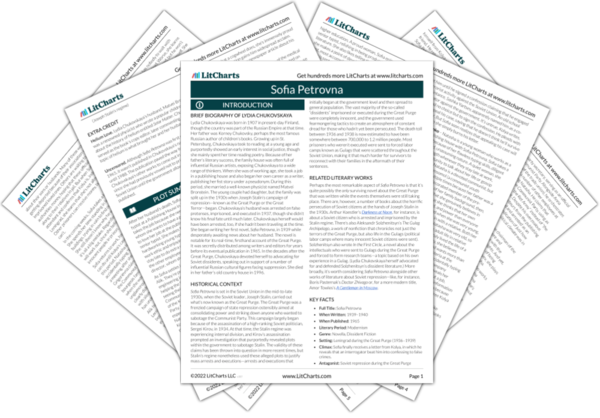Welcome to the LitCharts study guide on Lydia Chukovskaya's Sofia Petrovna. Created by the original team behind SparkNotes, LitCharts are the world's best literature guides.
Sofia Petrovna: Introduction
Sofia Petrovna: Plot Summary
Sofia Petrovna: Detailed Summary & Analysis
Sofia Petrovna: Themes
Sofia Petrovna: Quotes
Sofia Petrovna: Characters
Sofia Petrovna: Terms
Sofia Petrovna: Symbols
Sofia Petrovna: Theme Wheel
Brief Biography of Lydia Chukovskaya

Historical Context of Sofia Petrovna
Other Books Related to Sofia Petrovna
- Full Title: Sofia Petrovna
- When Written: 1939–1940
- When Published: 1965
- Literary Period: Modernism
- Genre: Novella, Dissident Fiction
- Setting: Leningrad during the Great Purge (1936–1939)
- Climax: Sofia finally receives a letter from Kolya, in which he reveals that an interrogator beat him into confessing to false crimes.
- Antagonist: Soviet repression during the Great Purge (Joseph Stalin’s regime)
Extra Credit for Sofia Petrovna
Helium Love. Lydia Chukovskaya’s husband, Matvei Bronstein, was a renowned physicist who wrote a popular children’s book about the history of helium entitled Solar Matter. Chukovskaya served as the book’s copy editor, later commenting that the topic of helium is what brought her and her husband together.
Uncensored. Although Sofia Petrovna was first published in 1965, it wasn’t published in Chukovskaya’s native Soviet Union until 1988. The publication paved the way for many of Chukovskaya’s other works to come out in the Soviet Union, since she had previously vowed not to print anything in the Soviet Union until the government allowed Sofia Petrovna to be published.







